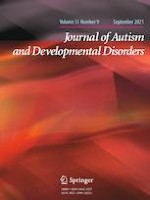11-11-2020 | Original Paper
Reduced Sensory Habituation in Autism and Its Correlation with Behavioral Measures
Gepubliceerd in: Journal of Autism and Developmental Disorders | Uitgave 9/2021
Log in om toegang te krijgenAbstract
Autism is strongly associated with sensory processing difficulties. We investigate sensory habituation, given its relevance for understanding important phenotypic traits like hyper- and hypo-sensitivities. We collected electroencephalography data from 22 neuro-typical(NT) and 13 autistic(ASD) children during the presentation of visual and auditory sequences of repeated stimuli. Our data show that the ASD children have significantly reduced habituation relative to the NT children for both auditory and visual stimuli. These results point to impaired habituation as a modality-general phenomenon in ASD. Additionally, the rates of habituation are correlated with several clinical scores associated with competence along diverse phenotypic dimensions. These data suggest that the sensory difficulties in autism are likely to be associated with reduced habituation and are related to clinical symptomology.
